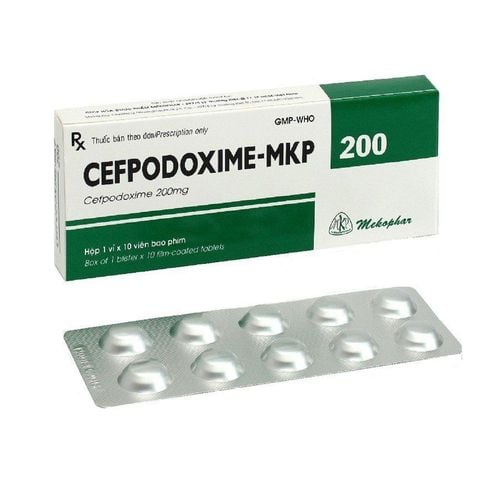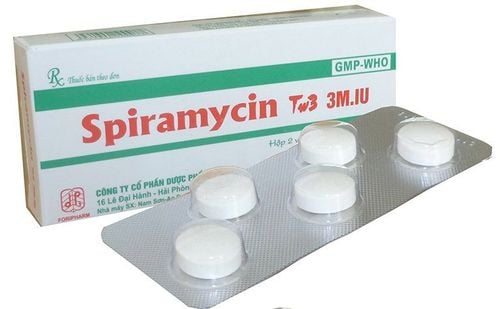This is an automatically translated article.
Sanbeclaneksi is used in the treatment of diseases of the upper respiratory tract and lower respiratory tract. Sanbeclaneksi is now available at all drugstores nationwide. Let's find out more details about the uses, usage and notes when using Sanbeclaneksi through the article below.
1. What is Sanbeclaneksi drug concept?
Sanbeclaneksi drug belongs to the group of drugs to treat parasites, anti-infectives, antivirals, antifungals. The drug is used in the treatment of upper respiratory tract infections and lower respiratory tract infections including: ear, nose and throat infections such as tonsillitis, sinusitis, otitis media, acute and chronic bronchitis, lobar pneumonia. , ...
The drug is prepared in the form of powder mixed with syrup 125mg/31.25mg and packed in a box of 1 bottle of 60ml.
Sanbeclaneksi drug, after mixing every 5ml of suspension, contains the main ingredients Amoxicilline and Clavulanic acid along with other excipients such as: Colloidal silicone dioxide, Xanthan gum, Saccharin Sodium, Succinic Acid, Mannitol 60 and Orange flavor.
2. What are the uses of Sanbeclaneksi?
Sanbeclaneksi is used in the following cases:
Upper respiratory tract infections (ear, nose, throat) such as otitis media, tonsillitis, sinusitis. Lower respiratory tract infections such as bronchopneumonia, acute and chronic bronchitis and lobar pneumonia. Genitourinary tract infections such as pyelonephritis, cystitis and urethritis. Skin and soft tissue infections such as abscesses, boils, cellulitis and wound infections. Bone and joint infections (osteomyelitis) Dental infections (alveolar abscesses) Other infections: intra-abdominal infections, miscarriage - septic abortion and obstetric infections.
3. Dosage - How to take the drug Sanbeclaneksi
3.1. Sanbeclaneksi can be used with reduced gastrointestinal tolerance, so patients should take the drug at the beginning of a meal and should not take the drug for more than 2 weeks without the supervision of a doctor or pharmacist. .
Instructions on how to mix: Leave the filtered water to a little below the line. Close the bottle tightly and turn the bottle upside down, shake, then stand upright for 5 minutes to ensure even dispersion. After reconstitution, this suspension should only be used within 7 days. Store in the refrigerator.
3.2. Dosage Dosage is expressed as specific Amoxicillin as follows:
Adults and children weighing > 40 kg
Patients with normal renal function: The recommended dose is 80 mg Amoxicillin/kg body weight. /day, divided into 3 times. Do not exceed 3g of Amoxicillin per day.
Renal impairment :
Creatinine clearance greater than 30 ml Amoxicillin/min: No dose adjustment required. Creatinine clearance from 10 to 30ml Amoxicillin/min: Doses should not exceed 15 mg Amoxicillin/kg body weight/dose, twice daily. Creatinine clearance less than 10 ml Amoxicillin/min: Doses should not exceed 15 mg Amoxicillin/kg body weight/day. Hemodialysis: 15 mg Amoxicillin/kg body weight/day during and after hemodialysis. Children weighing < 40 kg:
20 - 40 mg Amoxicillin/kg/day, divided into 3 oral doses/day, depending on the severity of the infection.
4. Contraindications to the use of Sanbeclaneksi
Sanbeclaneksi drug should not be used in the following cases:
The patient is allergic to the Beta-Lactam group such as Cephalosporins and Penicillins. Beta-lactam antibiotics such as cephalosporins should be considered for the possibility of cross-allergenicity. In case the patient has a history of jaundice or liver dysfunction due to taking Clavulanate and Amoxicillin or Penicillins because Clavulanic Acid increases the risk of cholestasis in the liver.
5. Sanbeclanksi drug interactions
When combined with Sanbeclaneksi drug with some of the following drugs may cause drug interactions such as:
Combined use of Probenecid with Amoxicillin will reduce the excretion of Amoxicillin in the renal tubules. Concomitant use of Probenecid with Clavulanic acid and Amoxicillin may increase blood levels of Amoxicillin. The concomitant use of these drugs is not recommended. Oral anticoagulants when combined with amoxicillin and Clavulanic acid may cause abnormal prolongation of prothrombin time. In this case, the dose of oral anticoagulants should be adjusted. Concomitant administration of Amoxicillin with Allopurinol significantly increases the incidence of rash in patients. Oral Contraceptives: Clavulanic acid and Amoxicillin can affect the intestinal microflora, leading to decreased estrogen reabsorption and decreased effectiveness of combined estrogen/progesterone oral contraceptives. Amoxicillin can lead to false (-) reactions in urine glucose testing.
6. Side effects when using Sanbeclaneksi for treatment
During the use of Sanbeclaneksi, patients may experience some unwanted effects such as:
Common side effects: Itching, diarrhea, rash. Side effects Uncommon: nausea/vomiting, eosinophilia, hepatitis and cholestatic jaundice, increased transaminases, erythema, rash. Rare side effects: Quincke's edema, anaphylaxis, pseudomembranous colitis, thrombocytopenia, leukopenia, hemolytic anemia, Stevens-Johnson syndrome, erythema multiforme, exfoliative dermatitis, interstitial nephritis, toxic epidermal necrolysis. Patients should inform the treating doctor or pharmacist of all possible side effects when using Sanbeclanksi medicine, for timely advice and treatment.
7. Precautions when using Sanbeclaneksi
Before using Sanbeclaneksi for treatment, patients need to carefully refer to the drug information on the instruction leaflet or according to the prescription that the doctor or pharmacist has prescribed.
There are insufficient scientific data on the safety and efficacy of Sanbeclanksi in pregnant women. Therefore, the drug should only be used during pregnancy when absolutely necessary and under the close supervision of a doctor and pharmacist. Amoxicillin has been reported to be excreted in human milk. Therefore, caution should be exercised when administering Sanbeclaneksi to nursing mothers. Safety and efficacy have been established for children weighing ≥ 40 kg when the tablet can be taken. When using Sanbeclanksi in the elderly, it is necessary to closely monitor renal function. Patients with renal failure who are on hemodialysis and those with creatinine clearance <30ml/min should not use Sanbeclaneksi. Care should be taken when determining the dose of the drug and monitoring liver function regularly in patients with hepatic impairment. The above is important information about the drug Sanbeclaneksi, if you have any other questions, you should ask your doctor for in-depth advice.
Please dial HOTLINE for more information or register for an appointment HERE. Download MyVinmec app to make appointments faster and to manage your bookings easily.













